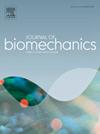软质与硬质背部支撑外骨骼对年轻人和老年人在重复性提举过程中躯干动态稳定性和躯干-骨盆协调性的影响。
IF 2.4
3区 医学
Q3 BIOPHYSICS
引用次数: 0
摘要
虽然背部支撑外骨骼作为人工材料搬运的一种人体工学干预措施越来越受欢迎,但它们可能会改变维持脊柱稳定性所需的神经肌肉控制。本研究评估了软质和硬质被动外骨骼对躯干局部动态稳定性和躯干-骨盆协调性的影响。132 名年轻(18-30 岁)和年长(45-60 岁)的男性和女性在使用两种不同的外骨骼和对照组的情况下完成了重复性的抬起和放下任务。两种外骨骼都明显降低了躯干的短期最大莱普诺夫指数(LyE)(p本文章由计算机程序翻译,如有差异,请以英文原文为准。
The effects of soft vs. rigid back-support exoskeletons on trunk dynamic stability and trunk-pelvis coordination in young and old adults during repetitive lifting
While back-support exoskeletons are increasing in popularity as an ergonomic intervention for manual material handling, they may cause alterations to neuromuscular control required for maintaining spinal stability. This study evaluated the effects of soft and rigid passive exoskeletons on trunk local dynamic stability and trunk-pelvis coordination. Thiry-two young (18–30 years) and old (45–60 years) men and women completed repetitive lifting and lowering tasks using two different exoskeletons and in a control condition. Both exoskeletons significantly reduced the short-term maximum Lyapunov exponent (LyE) of the trunk (p < 0.01), suggesting improved local dynamic stability. There was also a significant main effect of age (p = 0.05): older adults exhibited lower short-term LyE that young adults. Use of the soft exoskeleton significantly increased, while the rigid exoskeleton significantly decreased, long-term LyE, and these changes were more pronounced in the young group compared to the old group. Additionally, exoskeleton use resulted in significant increase (p < 0.001) of mean absolute relative phase (MARP) and deviation phase (DP) by ∼30–60 %, with greater increases due to the rigid than the soft device. Thus, trunk-pelvic coordination and coordination variability were negatively impacted by exoskeleton use. Potential reasons for these findings may include exoskeleton-induced changes in lifting strategy, reduced peak trunk flexion velocity, and cycle-to-cycle variability of trunk velocity. Furthermore, although the soft and rigid devices caused comparable changes in trunk-extensor muscle activity, they exhibited differential effects on long-term maximum Lyapunov exponents as well as trunk-pelvic coordination, indicating that exoskeleton design features can have complex effects on trunk neuromuscular control.
求助全文
通过发布文献求助,成功后即可免费获取论文全文。
去求助
来源期刊

Journal of biomechanics
生物-工程:生物医学
CiteScore
5.10
自引率
4.20%
发文量
345
审稿时长
1 months
期刊介绍:
The Journal of Biomechanics publishes reports of original and substantial findings using the principles of mechanics to explore biological problems. Analytical, as well as experimental papers may be submitted, and the journal accepts original articles, surveys and perspective articles (usually by Editorial invitation only), book reviews and letters to the Editor. The criteria for acceptance of manuscripts include excellence, novelty, significance, clarity, conciseness and interest to the readership.
Papers published in the journal may cover a wide range of topics in biomechanics, including, but not limited to:
-Fundamental Topics - Biomechanics of the musculoskeletal, cardiovascular, and respiratory systems, mechanics of hard and soft tissues, biofluid mechanics, mechanics of prostheses and implant-tissue interfaces, mechanics of cells.
-Cardiovascular and Respiratory Biomechanics - Mechanics of blood-flow, air-flow, mechanics of the soft tissues, flow-tissue or flow-prosthesis interactions.
-Cell Biomechanics - Biomechanic analyses of cells, membranes and sub-cellular structures; the relationship of the mechanical environment to cell and tissue response.
-Dental Biomechanics - Design and analysis of dental tissues and prostheses, mechanics of chewing.
-Functional Tissue Engineering - The role of biomechanical factors in engineered tissue replacements and regenerative medicine.
-Injury Biomechanics - Mechanics of impact and trauma, dynamics of man-machine interaction.
-Molecular Biomechanics - Mechanical analyses of biomolecules.
-Orthopedic Biomechanics - Mechanics of fracture and fracture fixation, mechanics of implants and implant fixation, mechanics of bones and joints, wear of natural and artificial joints.
-Rehabilitation Biomechanics - Analyses of gait, mechanics of prosthetics and orthotics.
-Sports Biomechanics - Mechanical analyses of sports performance.
 求助内容:
求助内容: 应助结果提醒方式:
应助结果提醒方式:


